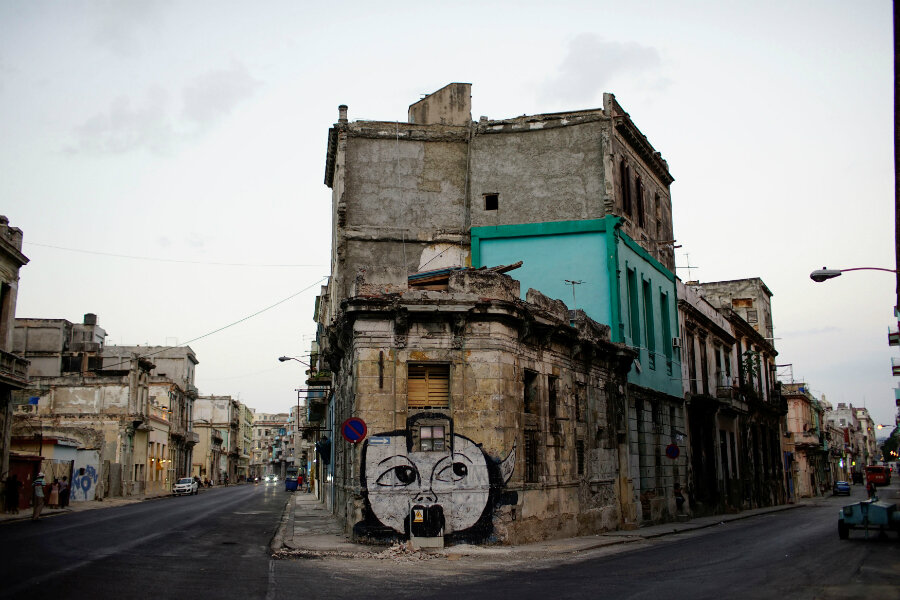A new voice finds expression in Cuba: graffiti artists
Loading...
| Havana
The graffiti of alien-like beings and balaclava-clad men appearing on Havana's dilapidated walls strikes a contrast with the upbeat political slogans and effigies of Cuban revolutionaries.
For a handful of young Cuban artists, these illicit creations are a means of touching on social issues in a coded way, ranging from fear of expressing oneself freely in public to growing materialism on the Communist-run island.
Graffiti was until recently uncommon in Cuba's tightly controlled public spaces. Its emergence reflects greater scope for critical expression under President Raul Castro and increasing influence of international culture as the country slowly opens.
Like Cuba's young bloggers, who are pushing the boundaries of what has been allowed in the media by starting news websites, its graffiti artists do not consider themselves dissidents and have been mostly tolerated by authorities.
"I want to create a social conscience with my work, an awareness about what we are turning into," said Yulier Rodriguez, whose alien-like creatures often look malformed, with limbs protruding from heads, and malnourished.
"A large part of society is going down a dark path," said Mr. Rodriguez, criticizing Cuba's ailing, Soviet-style economy that forces Cubans to turn to illegal activities to get by.
Locals joke, for example, that the only reason to work for the state, given the average monthly wage of $30, is to steal produce to sell on the black market.
Inspired by British and American street artists Banksy and Jean-Michel Basquiat, Rodriguez said his creatures often have no mouth, representing Cubans' reluctance to publicly express their discontent for fear of reprisals, such as losing jobs.
The same idea is behind the balaclava-clad men of artist Fabian Lopez, whose alias is 2+2=5, meaning something is not quite right.
The 20-year old stepped into the spotlight recently for a graffiti showing his character holding President Trump's head, reflecting Cubans' anger over the United States president's attitude toward opening US-Cuban relations.
Havana officials quickly painted over the image.
Like other graffiti artists, Mr. Lopez faces more practical challenges. In the absence of common spray paint, for instance, these artists use industrial spray paint designed for metals in limited colors.
"The other day I finished a work with oil when the black paint ran out," said Lopez, who creates as many as seven graffiti a day, keeping a record of them on Instagram.
Not for faint-hearted
On an island renowned for its culture, street art is not new. Havana is dotted with colorful state-sanctioned murals and projects like Fusterlandia, a neighborhood decorated with mosaics reminiscent of Catalan modernist architect Antoni Gaudi.
But, unlike the rest of Latin America, graffiti artists making pointed social critiques are pioneering the art form in Cuba.
William LeoGrande, a Cuba expert and professor of government at American University in Washington, said certain forms of cultural expression such as films were always given greater latitude for critical expression. He said the scope of what was allowed "within the revolution" had expanded since Raul Castro succeeded his brother Fidel in 2008.
All the artists said they had been questioned by police about their political intentions, beyond accusations of vandalism that are commonly leveled against graffiti artists around the world.
They said they do not directly challenge the government. Artists who do risk accusations of being counterrevolutionary and being detained.
"About five years ago, we realized that there was a bit more tolerance," said artist Osmany Carratala.
Known for his "happy zombies" symbolizing his view that Cubans, traumatized by past poverty, are now slaves of materialistic dreams, he said graffiti artists have kept up their guard because they do not know "when authorities could put the pressure on again."
One of Cuba's first prominent graffiti artists, Danilo Maldonado, emigrated to Miami in January.
Known as "El Sexto" ("the sixth") after spreading that tag around Havana to mock "the cult of five Cuban spies" sentenced to prison in the US in 2001, his critical work led to several imprisonments.
"It doesn't make much sense to stay somewhere where you can't do your art," Mr. Maldonado said in a telephone interview.
There is growing acceptance, however, for less overtly political graffiti. While state-run media have eschewed the phenomenon, the governmental Casa de las Americas hosted an exhibition of photos documenting it last month.
And many Cubans welcome the graffiti in public spaces.
"This place was basically in ruins before," said musician Raul Prades, pointing to the wall of a crumbling warehouse in Old Havana, plastered with graffiti. "And now, it's covered in art."
This story was reported by Reuters.





